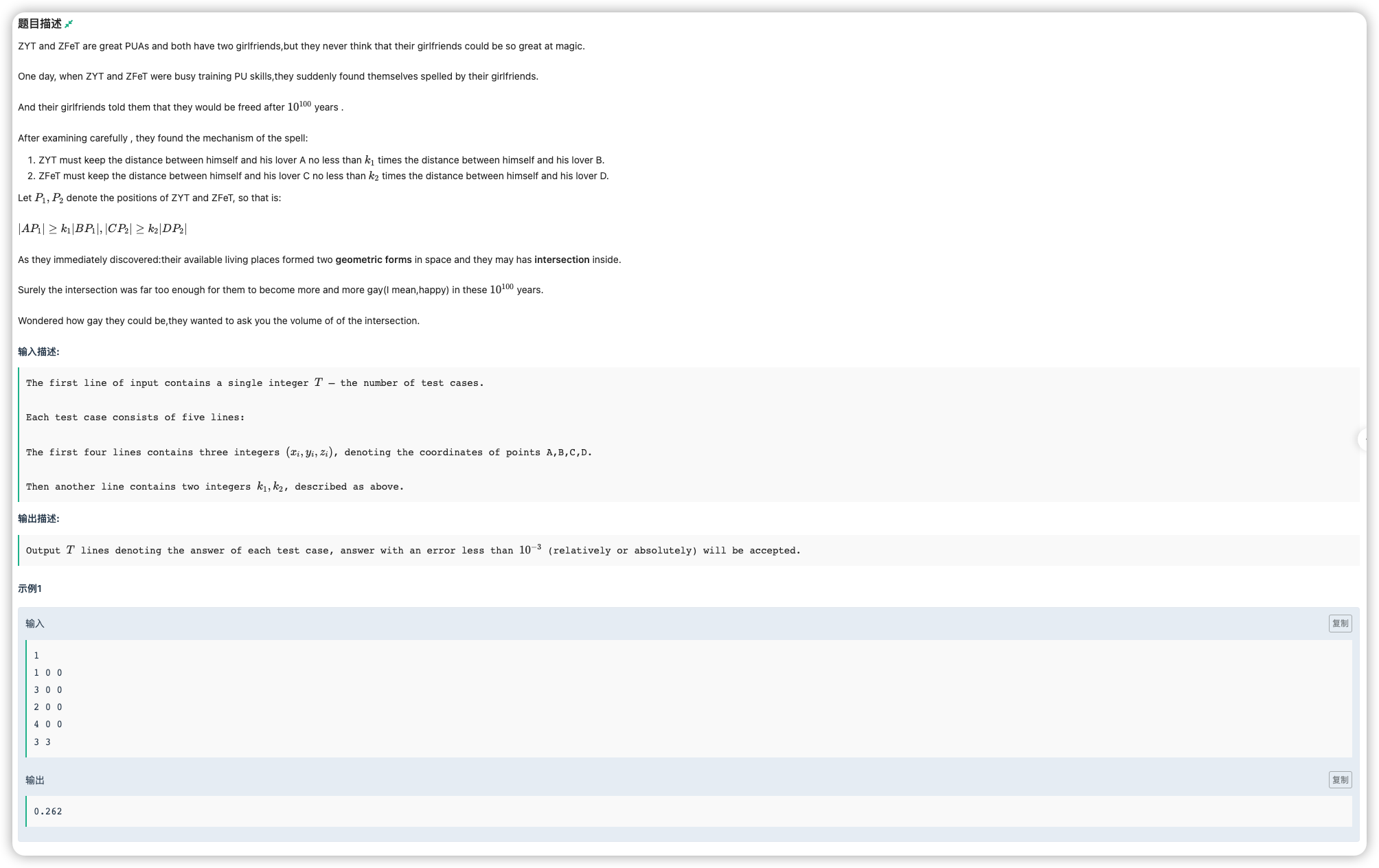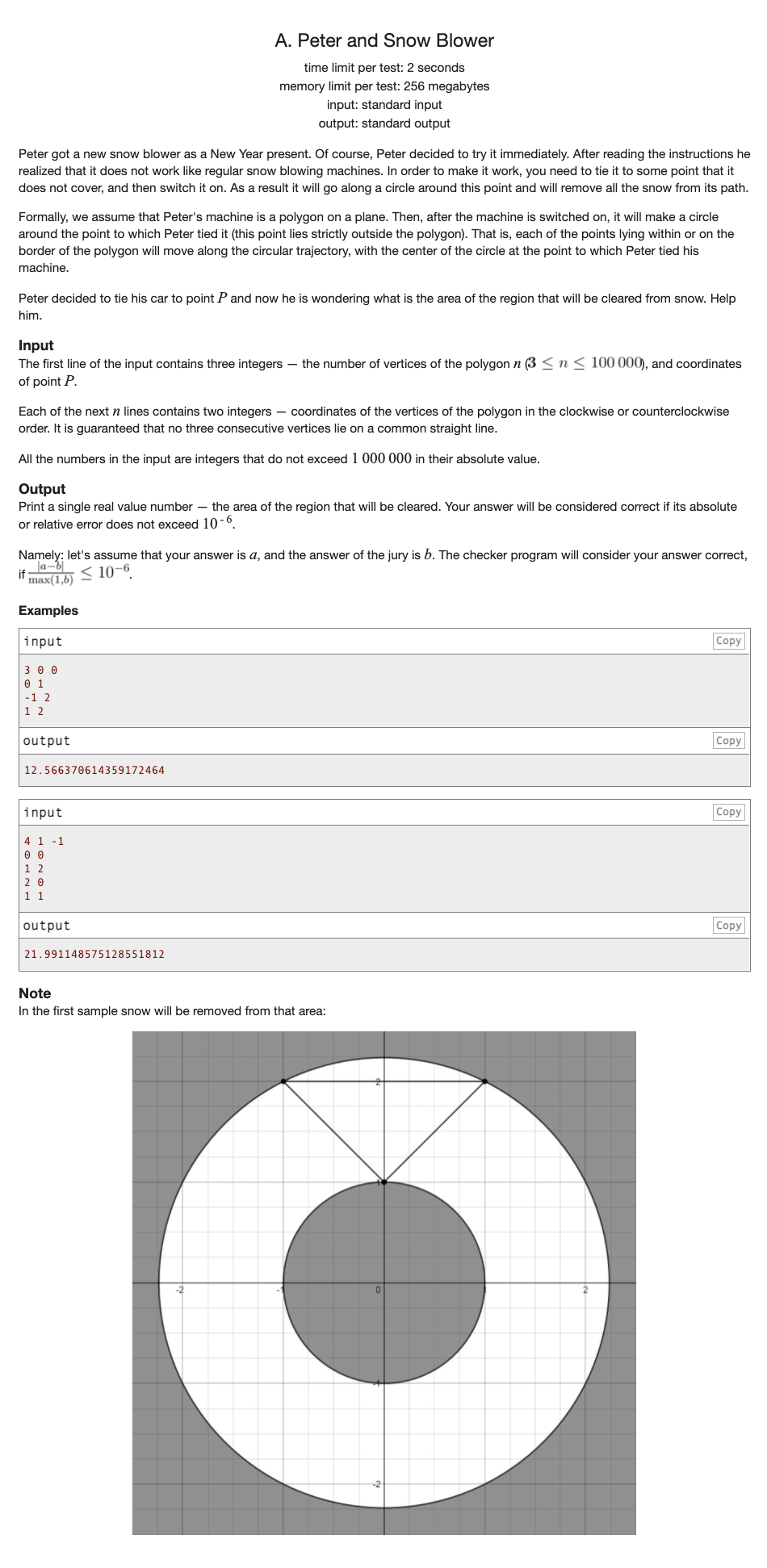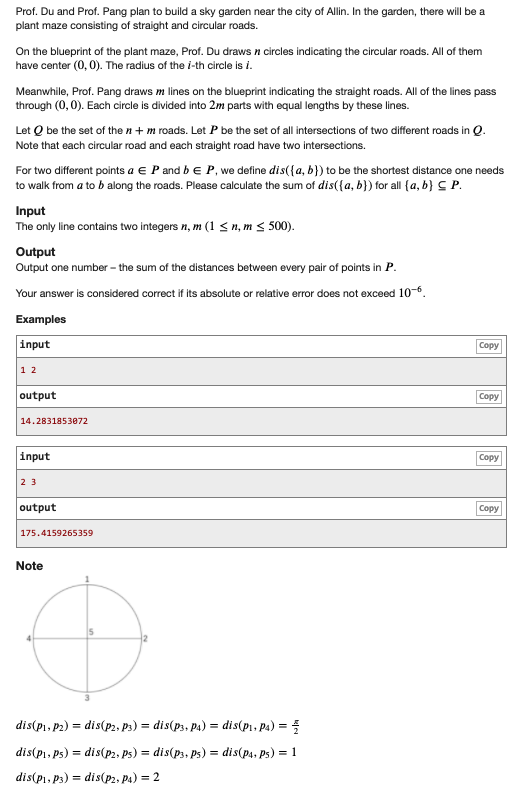计算几何
Chivas-Regal
#
# 牛客2021多校(1)B_BallDropping
# 🔗
https://ac.nowcoder.com/acm/contest/11166/B
# 💡
一个数学几何推导
在梯形尖端拼出一个三角形
利用三角形相似求解
⚠️:一定等公式化简完了再解,不然duoble会有精度丢失
# ✅
/*
________ _ ________ _
/ ______| | | | __ | | |
/ / | | | |__| | | |
| | | |___ _ _ _ ___ _ _____ | ___| ______ _____ ___ _ | |
| | | __ \ |_| | | | | | _\| | | ____| | |\ \ | __ | | _ | | _\| | | |
| | | | \ | _ | | | | | | \ | | \___ | | \ \ | |_/ _| | |_| | | | \ | | |
\ \______ | | | | | | \ |_| / | |_/ | ___/ | | | \ \ | /_ \__ | | |_/ | | |
Author : \________| |_| |_| |_| \___/ |___/|_| |_____| _________|__| \__\ |______| | | |___/|_| |_|
____| |
\_____/
*/
#include <unordered_map>
#include <algorithm>
#include <iostream>
#include <cstring>
#include <utility>
#include <string>
#include <vector>
#include <cstdio>
#include <stack>
#include <queue>
#include <cmath>
#include <map>
#include <set>
#define G 10.0
#define LNF 1e18
#define EPS 1e-6
#define PI acos(-1.0)
#define INF 0x7FFFFFFF
#define ll long long
#define ull unsigned long long
#define LOWBIT(x) ((x) & (-x))
#define LOWBD(a, x) lower_bound(a.begin(), a.end(), x) - a.begin()
#define UPPBD(a, x) upper_bound(a.begin(), a.end(), x) - a.begin()
#define TEST(a) cout << "---------" << a << "---------" << '\n'
#define CHIVAS_ int main()
#define _REGAL exit(0)
#define SP system("pause")
#define IOS ios::sync_with_stdio(false)
//#define map unordered_map
#define _int(a) int a; cin >> a
#define _ll(a) ll a; cin >> a
#define _char(a) char a; cin >> a
#define _string(a) string a; cin >> a
#define _vectorInt(a, n) vector<int>a(n); cin >> a
#define _vectorLL(a, b) vector<ll>a(n); cin >> a
#define PB(x) push_back(x)
#define ALL(a) a.begin(),a.end()
#define MEM(a, b) memset(a, b, sizeof(a))
#define EACH_CASE(cass) for (cass = inputInt(); cass; cass--)
#define LS l, mid, rt << 1
#define RS mid + 1, r, rt << 1 | 1
#define GETMID (l + r) >> 1
using namespace std;
template<typename T> inline T MAX(T a, T b){return a > b? a : b;}
template<typename T> inline T MIN(T a, T b){return a > b? b : a;}
template<typename T> inline void SWAP(T &a, T &b){T tp = a; a = b; b = tp;}
template<typename T> inline T GCD(T a, T b){return b > 0? GCD(b, a % b) : a;}
template<typename T> inline void ADD_TO_VEC_int(T &n, vector<T> &vec){vec.clear(); cin >> n; for(int i = 0; i < n; i ++){T x; cin >> x, vec.PB(x);}}
template<typename T> inline pair<T, T> MaxInVector_ll(vector<T> vec){T MaxVal = -LNF, MaxId = 0;for(int i = 0; i < (int)vec.size(); i ++) if(MaxVal < vec[i]) MaxVal = vec[i], MaxId = i; return {MaxVal, MaxId};}
template<typename T> inline pair<T, T> MinInVector_ll(vector<T> vec){T MinVal = LNF, MinId = 0;for(int i = 0; i < (int)vec.size(); i ++) if(MinVal > vec[i]) MinVal = vec[i], MinId = i; return {MinVal, MinId};}
template<typename T> inline pair<T, T> MaxInVector_int(vector<T> vec){T MaxVal = -INF, MaxId = 0;for(int i = 0; i < (int)vec.size(); i ++) if(MaxVal < vec[i]) MaxVal = vec[i], MaxId = i; return {MaxVal, MaxId};}
template<typename T> inline pair<T, T> MinInVector_int(vector<T> vec){T MinVal = INF, MinId = 0;for(int i = 0; i < (int)vec.size(); i ++) if(MinVal > vec[i]) MinVal = vec[i], MinId = i; return {MinVal, MinId};}
template<typename T> inline pair<map<T, T>, vector<T> > DIV(T n){T nn = n;map<T, T> cnt;vector<T> div;for(ll i = 2; i * i <= nn; i ++){while(n % i == 0){if(!cnt[i]) div.push_back(i);cnt[i] ++;n /= i;}}if(n != 1){if(!cnt[n]) div.push_back(n);cnt[n] ++;n /= n;}return {cnt, div};}
template<typename T> vector<T>& operator-- (vector<T> &v){for (auto& i : v) --i; return v;}
template<typename T> vector<T>& operator++ (vector<T> &v){for (auto& i : v) ++i; return v;}
template<typename T> istream& operator>>(istream& is, vector<T> &v){for (auto& i : v) is >> i; return is;}
template<typename T> ostream& operator<<(ostream& os, vector<T> v){for (auto& i : v) os << i << ' '; return os;}
inline int inputInt(){int X=0; bool flag=1; char ch=getchar();while(ch<'0'||ch>'9') {if(ch=='-') flag=0; ch=getchar();}while(ch>='0'&&ch<='9') {X=(X<<1)+(X<<3)+ch-'0'; ch=getchar();}if(flag) return X;return ~(X-1);}
inline void outInt(int X){if(X<0) {putchar('-'); X=~(X-1);}int s[20],top=0;while(X) {s[++top]=X%10; X/=10;}if(!top) s[++top]=0;while(top) putchar(s[top--]+'0');}
inline ll inputLL(){ll X=0; bool flag=1; char ch=getchar();while(ch<'0'||ch>'9') {if(ch=='-') flag=0; ch=getchar();}while(ch>='0'&&ch<='9') {X=(X<<1)+(X<<3)+ch-'0'; ch=getchar();}if(flag) return X;return ~(X-1); }
inline void outLL(ll X){if(X<0) {putchar('-'); X=~(X-1);}ll s[20],top=0;while(X) {s[++top]=X%10; X/=10;}if(!top) s[++top]=0;while(top) putchar(s[top--]+'0');}
CHIVAS_{
double r, a, b, h;
cin >> r >> a >> b >> h;
if(4 * h * h + a * a - 2 * a * b + b * b < 0 ||
a == b || (r * sqrt(4 * h * h + a * a - 2 * a * b + b * b) - h * b ) / (a - b) < 0){
cout << "Drop" << endl;
}else{
cout << "Stuck" << endl;
printf("%.10f", (r * sqrt(4 * h * h + a * a - 2 * a * b + b * b) - h * b) / (a - b));
}
_REGAL;
};
1
2
3
4
5
6
7
8
9
10
11
12
13
14
15
16
17
18
19
20
21
22
23
24
25
26
27
28
29
30
31
32
33
34
35
36
37
38
39
40
41
42
43
44
45
46
47
48
49
50
51
52
53
54
55
56
57
58
59
60
61
62
63
64
65
66
67
68
69
70
71
72
73
74
75
76
77
78
79
80
81
82
83
84
85
86
87
88
89
90
91
92
93
94
95
96
97
98
2
3
4
5
6
7
8
9
10
11
12
13
14
15
16
17
18
19
20
21
22
23
24
25
26
27
28
29
30
31
32
33
34
35
36
37
38
39
40
41
42
43
44
45
46
47
48
49
50
51
52
53
54
55
56
57
58
59
60
61
62
63
64
65
66
67
68
69
70
71
72
73
74
75
76
77
78
79
80
81
82
83
84
85
86
87
88
89
90
91
92
93
94
95
96
97
98
# 牛客多校2021(2)F_Girlfriend
# 🔗
# 💡
先看一个人,他可以活动的位置设为 ,两个女朋友在 ,距离倍数为 写一下式子
发现这是一个球,算出其中心点、半径
然后算球的体积交即可
# ✅
const double PI = acos(-1.0);
struct Point { double x, y, z; };
struct Ball { Point p; double r2, r; };
inline Ball person (Point a, Point b, double k) {
Ball res;
double down = 1 - k * k;
double _a = (k * k * b.x - a.x) / down;
double _b = (k * k * b.y - a.y) / down;
double _c = (k * k * b.z - a.z) / down;
double _d = (a.x * a.x + a.y * a.y + a.z * a.z - k * k * b.x * b.x - k * k * b.y * b.y - k * k * b.z * b.z) / down;
res.p = {-_a, -_b, -_c};
res.r2 = _a * _a + _b * _b + _c * _c - _d;
res.r = sqrt(res.r2);
return res;
}
inline double distance (Point a, Point b) {
return sqrt((a.x - b.x) * (a.x - b.x) + (a.y - b.y) * (a.y - b.y) + (a.z - b.z) * (a.z - b.z));
}
inline double distance2 (Point a, Point b) {
return (a.x - b.x) * (a.x - b.x) + (a.y - b.y) * (a.y - b.y) + (a.z - b.z) * (a.z - b.z);
}
inline double in (Ball a, Ball b) {
double dis2 = distance2(a.p, b.p);
double dis = distance(a.p, b.p);
if (dis >= a.r + b.r) return 0;
else if (dis + a.r <= b.r) return PI * a.r * a.r * a.r * 4 / 3;
else if (dis + b.r <= a.r) return PI * b.r * b.r * b.r * 4 / 3;
double h1 = a.r - (a.r2 + dis2 - b.r2) / (dis * 2);
double h2 = b.r - (b.r2 + dis2 - a.r2) / (dis * 2);
double V = PI * h1 * h1 * (a.r - h1 / 3) + PI * h2 * h2 * (b.r - h2 / 3);
return V;
}
int main () {
int t; scanf("%d", &t); while (t --) {
Point a, b;
scanf("%lf%lf%lf%lf%lf%lf", &a.x, &a.y, &a.z, &b.x, &b.y, &b.z);
Point c, d;
scanf("%lf%lf%lf%lf%lf%lf", &c.x, &c.y, &c.z, &d.x, &d.y, &d.z);
double k1, k2 ;scanf("%lf%lf", &k1, &k2);
printf("%.3f\n", in(person(a, b, k1), person(c, d, k2)));
}
}
1
2
3
4
5
6
7
8
9
10
11
12
13
14
15
16
17
18
19
20
21
22
23
24
25
26
27
28
29
30
31
32
33
34
35
36
37
38
39
40
41
42
43
44
45
46
2
3
4
5
6
7
8
9
10
11
12
13
14
15
16
17
18
19
20
21
22
23
24
25
26
27
28
29
30
31
32
33
34
35
36
37
38
39
40
41
42
43
44
45
46
# CodeForces613A_PeterAndSnowBlower
# 🔗
# 💡
一个计算几何问题
首先我们考虑外围圆半径R,就是离圆心最远的直接就可以从点中找到
但是考虑内圈圆半径r的时候,我们需要寻找圆心到边的最近距离即可(计算几何板子扔上去)
最后答案就是 ( R * R - r * r ) * PI
# ✅
#include <iostream>
#include <algorithm>
#include <map>
#include <cmath>
#include <vector>
#include <cstring>
#include <list>
using namespace std;
#define ll long long
const ll mod = 998244353;
const double PI = acos(-1.0);
const double eps = 1e-9;
inline ll sgn ( double x ) {
if ( x < -1e-9 ) return -1;
else if ( x > 1e-9 ) return 1;
return 0;
}
struct point {
double x, y;
point () {}
point ( double a, double b ) : x(a), y(b) {}
point operator + ( point b ) const {
return point ( x + b.x, y + b.y );
}
point operator - ( point b ) const {
return point ( x - b.x, y - b.y );
}
double operator * ( point b ) const {
return x * b.x + y * b.y;
}
double operator ^ ( point b ) const {
return x * b.y - y * b.x;
}
};
inline point proj ( point a, point k1, point k2 ) {
point res;
double dx = k1.x - k2.x;
double dy = k1.y - k2.y;
double u = (a.x - k1.x) * (k1.x - k2.x) + (a.y - k1.y) * (k1.y - k2.y);
u = u / ((dx * dx) + (dy * dy));
res.x = k1.x + u * dx;
res.y = k1.y + u * dy;
return res;
}
inline bool OnSeg ( point p, point a, point b ) {
return sgn ( ( a - p ) ^ ( b - p ) ) == 0 &&
sgn ( (p.x - a.x) * (p.x - b.x) ) <= 0 &&
sgn ( ( p.y - a.y ) * (p.y - b.y) );
}
inline double dist ( point a, point b ) {
double dirx = a.x - b.x;
double diry = a.y - b.y;
return sqrt ( dirx * dirx + diry * diry );
}
inline point PointLine ( point p, point a, point b ) {
point result;
double t = ( ( p - a ) * ( b - a ) ) / ( ( b - a ) * ( b - a ));
if ( t >= 0 && t <= 1 ) {
result.x = a.x + (b.x - a.x) * t;
result.y = a.y + (b.y - a.y) * t;
} else {
if ( dist ( p, a ) < dist ( p, b ) ) result = a;
else result = b;
}
return result;
}
int main () {
#ifndef ONLINE_JUDGE
freopen("in.in", "r", stdin);
freopen("out.out", "w", stdout);
#endif
ll n;
double X, Y;
cin >> n >> X >> Y;
point PT = {X, Y};
vector<point> pt;
double r = 10000000000000000, R = 0;
for ( ll i = 0; i < n; i ++ ) {
double a, b; cin >> a >> b;
pt.push_back({a, b});
if ( dist(PT, pt.back()) - R > eps ) R = dist(PT, pt.back());
}
for ( int i = 0; i < n; i ++ ) {
point near = PointLine ( PT, pt[i], pt[(i + 1) % n]);
if ( r - dist(PT, near) > eps ) r = dist(PT, near);
}
printf("%.10f\n", (R * R - r * r) * PI);
}
1
2
3
4
5
6
7
8
9
10
11
12
13
14
15
16
17
18
19
20
21
22
23
24
25
26
27
28
29
30
31
32
33
34
35
36
37
38
39
40
41
42
43
44
45
46
47
48
49
50
51
52
53
54
55
56
57
58
59
60
61
62
63
64
65
66
67
68
69
70
71
72
73
74
75
76
77
78
79
80
81
82
83
84
85
86
87
88
89
90
91
92
93
94
95
96
2
3
4
5
6
7
8
9
10
11
12
13
14
15
16
17
18
19
20
21
22
23
24
25
26
27
28
29
30
31
32
33
34
35
36
37
38
39
40
41
42
43
44
45
46
47
48
49
50
51
52
53
54
55
56
57
58
59
60
61
62
63
64
65
66
67
68
69
70
71
72
73
74
75
76
77
78
79
80
81
82
83
84
85
86
87
88
89
90
91
92
93
94
95
96
# ICPC上海站2020I_SkyGarden
# 🔗
# 💡
这些点的排布有规律,所以我们分析一下所有可能的点对距离
同圈:看看走直线和走曲线哪个更近,由于是等分,所以这两个都很好求出
异圈:外圈的先走到小圈,然后看看走直线和走曲线哪个更近
易知道,同圈上一个点访问该圈所有的点求出之后设为 ,外圈上一个点访问这圈所有点在这圈上走的距离是
所以这道题的关键就在于遍历每一圈,求出这圈上一个点访问所有点的距离,然后用外圈所有的点套这个距离就行了
那么我们就可以把问题分为“圈上选择走法”和“直线走法”
圈上选择走法:
从内圈向外遍历圈数,第 圈求出
,该圈互相访问需要
,比这圈层数大的点的个数为
,去访问这所有点在圈上选择走法总距离为
直线走法:
每一次外圈要访问该圈所有点都要先走到这圈,那么每一个点到这个圈的距离为 ,每个点访问这圈所有点要走
次
总距离就是
注意,当分割线数量不为 时,还有个所有点到圆心的距离
也就是
C++ 精度一直出问题,所以换成 Java 来做
# ✅
public class Main{
static BigDecimal mysol(int n, int m) {
BigDecimal res1 = BigDecimal.ZERO, res2 = BigDecimal.ZERO; // 圈上选择,直接直线
for ( int dp = 1; dp <= n; dp ++ ) { // 枚举第几圈
BigDecimal line = BigDecimal.valueOf(dp).multiply(BigDecimal.valueOf(2)).multiply(BigDecimal.valueOf(m)); // 走直线的话需要的步数
BigDecimal one_arc = BigDecimal.valueOf(dp).multiply(BigDecimal.valueOf(Math.PI)); // 一个弧
BigDecimal cur = BigDecimal.ZERO; // 圈上每个点到该圈所有点的距离和
for ( int i = 1; i < m; i ++ ) {
if ( line.compareTo(one_arc.multiply(BigDecimal.valueOf(i))) == 1 ) cur = cur.add(one_arc.multiply(BigDecimal.valueOf(i)));
else cur = cur.add(line);
}
cur = cur.multiply(BigDecimal.valueOf(2));
cur = cur.add(line);
res1 = res1.add(cur.multiply(BigDecimal.valueOf(n).subtract(BigDecimal.valueOf(dp))).multiply(BigDecimal.valueOf(2))).add(cur); // 外圈和该圈所有点在该圈上移动的距离和
res2 = res2.add(BigDecimal.valueOf(m).multiply(BigDecimal.valueOf(1 + n - dp)).multiply(BigDecimal.valueOf(n - dp)).multiply(BigDecimal.valueOf(2 * m))); // 外圈到该圈需要的距离和
}
if ( m != 1 ) res2 = res2.add(BigDecimal.valueOf(m * n * (n + 1))); // 有圆心,要加所有点到圆心的距离和
return res1.add(res2);
}
public static void main(String[] args) {
Scanner input = new Scanner(System.in);
int n = input.nextInt(), m = input.nextInt();
String res = String.format("%.10f", mysol(n, m));
System.out.println(res);
}
}
1
2
3
4
5
6
7
8
9
10
11
12
13
14
15
16
17
18
19
20
21
22
23
24
25
26
27
28
2
3
4
5
6
7
8
9
10
11
12
13
14
15
16
17
18
19
20
21
22
23
24
25
26
27
28



